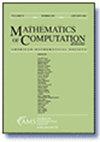A blob method for inhomogeneous diffusion with applications to multi-agent control and sampling
IF 2.2
2区 数学
Q1 MATHEMATICS, APPLIED
引用次数: 3
Abstract
As a counterpoint to classical stochastic particle methods for linear diffusion equations, such as Langevin dynamics for the Fokker-Planck equation, we develop a deterministic particle method for the weighted porous medium equation and prove its convergence on bounded time intervals. This generalizes related work on blob methods for unweighted porous medium equations. From a numerical analysis perspective, our method has several advantages: it is meshfree, preserves the gradient flow structure of the underlying PDE, converges in arbitrary dimension, and captures the correct asymptotic behavior in simulations. The fact that our method succeeds in capturing the long time behavior of the weighted porous medium equation is significant from the perspective of related problems in quantization. Just as the Fokker-Planck equation provides a way to quantize a probability measure ρ ¯ \bar {\rho } by evolving an empirical measure ρ N ( t ) = 1 N ∑ i = 1 N δ X i ( t ) \rho ^N(t) = \frac {1}{N} \sum _{i=1}^N \delta _{X^i(t)} according to stochastic Langevin dynamics so that ρ N ( t ) \rho ^N(t) flows toward ρ ¯ \bar {\rho } , our particle method provides a way to quantize ρ ¯ \bar {\rho } according to deterministic particle dynamics approximating the weighted porous medium equation. In this way, our method has natural applications to multi-agent coverage algorithms and sampling probability measures. A specific case of our method corresponds to confined mean-field dynamics of training a two-layer neural network for a radial basis activation function. From this perspective, our convergence result shows that, in the overparametrized regime and as the variance of the radial basis functions goes to zero, the continuum limit is given by the weighted porous medium equation. This generalizes previous results, which considered the case of a uniform data distribution, to the more general inhomogeneous setting. As a consequence of our convergence result, we identify conditions on the target function and data distribution for which convexity of the energy landscape emerges in the continuum limit.非均匀扩散的blob方法及其在多智能体控制和采样中的应用
作为线性扩散方程的经典随机粒子方法(如Fokker-Planck方程的Langevin动力学)的对比,我们开发了加权多孔介质方程的确定粒子方法,并证明了其在有界时间间隔上的收敛性。这推广了关于未加权多孔介质方程的blob方法的相关工作。从数值分析的角度来看,我们的方法有几个优点:它是无网格的,保留了底层PDE的梯度流结构,在任意维度上收敛,并在模拟中捕捉到正确的渐近行为。从量化中的相关问题来看,我们的方法成功地捕捉到了加权多孔介质方程的长时间行为,这一事实具有重要意义。正如Fokker-Planck方程提供了一种根据随机Langevin动力学通过演化经验测度ρN(t)=1 N∑i=1 NδX i(t)=\frac{1}{N}\sum_,我们的粒子方法提供了一种根据确定性粒子动力学近似加权多孔介质方程来量化ρ\bar{\rho}的方法。这样,我们的方法自然地应用于多智能体覆盖算法和采样概率度量。我们方法的一个具体情况对应于为径向基激活函数训练两层神经网络的受限平均场动力学。从这个角度来看,我们的收敛结果表明,在过框架化的情况下,当径向基函数的方差为零时,连续极限由加权多孔介质方程给出。这将先前考虑均匀数据分布情况的结果推广到更一般的非均匀设置。由于我们的收敛结果,我们确定了目标函数和数据分布上的条件,对于这些条件,能量景观的凸性出现在连续体极限中。
本文章由计算机程序翻译,如有差异,请以英文原文为准。
求助全文
约1分钟内获得全文
求助全文
来源期刊

Mathematics of Computation
数学-应用数学
CiteScore
3.90
自引率
5.00%
发文量
55
审稿时长
7.0 months
期刊介绍:
All articles submitted to this journal are peer-reviewed. The AMS has a single blind peer-review process in which the reviewers know who the authors of the manuscript are, but the authors do not have access to the information on who the peer reviewers are.
This journal is devoted to research articles of the highest quality in computational mathematics. Areas covered include numerical analysis, computational discrete mathematics, including number theory, algebra and combinatorics, and related fields such as stochastic numerical methods. Articles must be of significant computational interest and contain original and substantial mathematical analysis or development of computational methodology.
 求助内容:
求助内容: 应助结果提醒方式:
应助结果提醒方式:


